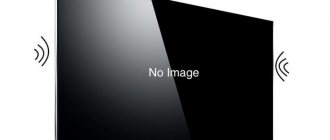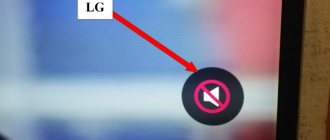The products of the South Korean company Samsung have proven themselves well in the modern market. In addition to the consistent quality of products, this manufacturer focuses on the widespread use of advanced technologies. For example, among the assortment of relevant stores you can find ultra-modern Samsung television equipment with a curved LED matrix.
However, even the best quality equipment sometimes fails. One of the common problems faced by owners of television electrical equipment is the so-called black screen. In other words, the image of this device disappears. At the same time, it obviously picks up a television signal, since there are no problems with sound.
It is quite possible that turning off such a device, for which the picture has disappeared, can only be done forcibly, after removing the plug from the socket.
You can try to figure out on your own why the Samsung TV has sound, but there is no picture, and carry out the repair yourself.
Causes
The most common malfunctions of Samsung TVs include the following malfunctions during their operation:
- dark image;
- the screen turned black;
- the sound disappears.
The causes of breakdowns may be the following:
- disconnection from the socket or inoperability of the wire;
- failure of the inverter - the device for supplying voltage to the backlight lamps;
- inoperability of the matrix, system board, backlight unit;
- problems with the converter, decoder and decoder;
- failure of the power supply unit or board.
Do not forget that the lack of brightness or sound transmission on a television device is quite possibly caused by a failure of the settings that are familiar to the eye and ear. In such a situation, you will simply need to bring them to comfortable parameters.
If we talk about real problems associated with the operation of the device, then a fairly common situation is when, after watching it, it was turned off, and when turned on later, they discovered that the video on it had disappeared. In the situation described, most likely one of the working elements of this equipment requires replacement or repair. But first things first.
Some useful tips
In a situation where there is no image, but there is sound, you can take the following actions:
- Turn off and turn on the TV after a few minutes. There may be a system failure.
- We check the antenna cable connection and connectors. The wire may have broken.
- Raise the volume to the limit. Usually after such actions the TV begins to work stably.
- If there are constant power surges in the network, install an uninterruptible power supply.
Use the TV carefully to prevent mechanical damage and accidental exposure to moisture.
Nature of the failure
As mentioned above, in addition to the fact that the device in question may work, but does not show a picture, there is a possibility of encountering the following display defects:
- vertical and (or) horizontal stripes;
- spot on the display;
- the contrast and (or) brightness are lost (impaired);
- the image on the TV flickers;
- doubles;
- half the screen became dark;
- no picture clarity;
- does not turn on or goes out after a while.
The technical documentation included with any modern electrical equipment usually contains recommendations for diagnosing and eliminating some of the above defects. To get out of some situations, listening to them is really useful.
How does the problem manifest itself?
If there is no picture, but the audio track is still playing on the TV, you can easily solve the problem yourself.
First you need to decide on the type of malfunction, because it can manifest itself in different ways:
- There is no picture (maybe just a black screen), but the channels are switched and the sound volume is adjusted using the remote control;
- Lost image with inability to navigate through channels . At the same time there is sound. Often, instead of the sound of the saved TV channel, error signals are heard;
- The backlight does not work. If a picture appears when you hold a flashlight (or other light source) close to the screen, the LED backlight on the TV has stopped working. The image is there, it’s just that the eyes practically don’t perceive it;
- Picture distortion. The system changes the image proportions, TV channels are shown in poor quality, and so on;
- The color scheme has changed , the picture has become dull;
- The TV works, but while watching the screen turns off spontaneously and turns on again after a reboot.
Fig.2
Please note that other types of problems may occur, but the options described above are the most common. The remaining distortions are mostly related to problems with the signal or Internet connection.
Diagnostics
Obviously, if the screen of your Samsung TV has darkened, then it needs qualified diagnostics to determine what exactly is broken. An experienced electronics repairman will test the functionality of the elements of the equipment submitted for repair and determine whether in this particular case it will be necessary to replace the matrix or some other manipulations on it.
The simplest diagnostics can be done with your own hands. In particular, if your Samsung device has a flickering screen, flickering images, or streaks on its display, check the quality of all external connections of the wires connected to it.
We recommend using the self-diagnosis function, which is equipped with all modern models. You can find the corresponding item in the main menu – Support – Self-diagnosis.
In some cases, calibrating the LCD TV will help solve the problem.
However, if, nevertheless, on the LED display of the Samsung device in question there is no displayed image, but there is sound transmission, most likely there are problems with its backlight or other internal electronic modules, the solution of which will require professional intervention.
Prevention for stable operation of the TV
Any digital device requires care and careful use to extend its service life.
For modern TVs, which have become more like computers (they have their own operating system), there are also some tips to keep them “living”.
- Most of all, any electrical appliance is “afraid” of voltage surges. Use UPS, stabilizers;
- You cannot leave the TV on for a long time. This applies to those who like to use it as a radio. Or fall asleep listening to the series, leaving to work until the morning;
- Make sure that the TV is not subjected to physical impacts (impacts, sharp shocks). There should not be any liquids nearby - water, tea, coffee, etc.
With careful use of any TV, you can significantly increase the time it is used. It is convenient to adhere to the last point if you mount the TV on the wall.
Repair
Depending on the type of malfunction, due to which the equipment in question has sound but no picture, Samsung TV repairs are carried out in different ways. In addition, troubleshooting methods may vary depending on its design.
To solve the problem, tidy up the contacts both inside and outside the Samsung LCD TV. In addition, sometimes a complete replacement of the matrix (plasma screen) is required. Let's take a closer look at situations that require repair work, in which the display on the display of Samsung television equipment has disappeared, but the sound remains.
Testing the cable
If the picture on the Samsung TV is gone, but the sound is still there, then it is advisable to check the cable’s serviceability, because With a high degree of probability, it was the cord that caused the problem. At home, this can be done by connecting it to a known working device, or replacing it with a known working cable.
If on a Samsung LCD TV that previously worked flawlessly, when connected through the cable being tested, there is sound transmission but no picture display, then this conductor is broken and must be replaced with a new one.
All of the above is also true for connections via an HDMI cable.
Inverter
The following signs may indicate a malfunction of the inverter that supplies voltage to the backlight lamps:
- the display flashes;
- there is sound, but no display;
- the backlight turns on but immediately goes out;
- display violation (for example, the device in question shows what is obviously a color TV program in black and white);
- Uneven backlight (brightness) of the display.
The weak point of modern television inverters can be considered high-voltage transformers, which are subject to increased load during operation.
Backlight
The reason for the lack of display on the display of television equipment may be the inoperability of its backlight. Try taking a flashlight and shining it on the dark surface of the turned on device. If you can see anything, then this is a sure symptom of problems with the backlight lamps, the voltage to which is supplied by the inverter. Another two signs of their non-working condition may be blackouts or, conversely, white spots on the TV display.
Manufacturers of digital equipment claim that backlight lamps must be replaced only in conjunction with the matrix, which makes fixing this problem a very expensive procedure.
Power supply or board
A malfunction of the power supply or power board can be determined by one of the following symptoms:
- there is no picture on the display (in particular, the image disappears, but sound transmission works);
- image disturbance (kinks, stripes, the device shows a color TV program in black and white);
- The display appears with a delay, or only after several attempts to turn on.
Most often, problems in this part of the structure are caused by the failure of capacitor filters, which in this case must be replaced.
Conclusion
Various complex image restoration procedures require certain technical knowledge, so it will be difficult to repair the TV yourself. So the average user is better off limiting himself to an external inspection of the TV panel and eliminating possible problems. There are many reasons why the TV screen went dark, but the sound remained, so first of all you need to check the simplest options:
- The connecting cable must be intact and without twisting. If deformation is detected, it must be replaced with a new one.
- Make sure the plugs fit tightly into the sockets.
- Try to protect the TV from mechanical influences.
- Many modern TV models have a dark screen function, in which the sound continues to be broadcast. Check your settings to see if this feature is enabled.
- Install an uninterruptible power supply if the network voltage is unstable.
System faults
If during the test it was found that everything is normal with the screen, that is, current is flowing to it, they figure out why the signal is not output correctly.
No video signal
Thunderbolt cable Composite and component cables are used to transmit sound and video, where the signals travel through a separate wire. Therefore, if there is no picture, the wire may have deteriorated. What cords are used for television equipment:
- RCA. People call them “tulips” for their floral colors. With their help, digital set-top boxes, DVD players and other media devices are connected to TV;
- HDMI/VGA. Component ones, where there are several wires, but one plug, with many pins. It happens that the cable responsible for transmitting the video signal fails.
This often happens with Thunderbolt and USB Type-C cables. But the absence of a picture on the screen does not always indicate a damaged wire, so it is better to double-check it by connecting it to another device. If it doesn’t work there either, a replacement is needed.
Decoder fault
UHF antenna Even if everything is normal with the wiring, the video signal is transmitted as expected, but the screen goes out and does not light up - perhaps the problem is the incorrect operation of the decoder, which cannot convert the “digital” signal into an analog signal.
TVs have different input devices, which determines the location of the decoder:
- digital TV. External devices, including the UHF antenna, “communicate” with it directly, and the signal is transmitted in binary code. The TV “understands” this code and itself transforms it into a more familiar one in order to subsequently display it on the screen. He is also responsible for decryption, so they look for the decoder somewhere in the equipment body;
- analog. Picture and sound are received in the usual form, each signal in a separate wire (AV, RCA, SCART). The decoder here is a digital receiver or a video card of a laptop or PC.
Solutions:
- Give the TV or receiver to a technician for further repairs, during which the decoder will be replaced (usually this device costs more than the service itself).
- Buy a digital receiver. Then the TV will receive its usual signal. In order for equipment to decrypt over-the-air, cable or satellite formats, the receiver must support DVB-T2, DVB-C, DVB-S
We fix the problem ourselves
Before carrying out any repair work, you should conditionally divide all your actions into three stages:
- Determine the nature of the failure using the guide described below;
- Run diagnostics. This includes finding a broken hardware component or finding the cause of a software bug;
- Repair. If you have basic microprocessor repair skills, fixing a broken component should be fairly easy. In any case, on YouTube you can find a lot of instructions for repairing any TV model. For those who do not want to start repairs themselves, we recommend contacting a service center. However, it is better to independently determine the nature of the breakdown in advance. This will protect you from possible overpayment at the service center.
Follow the steps below to fix the missing picture problem on TV.











